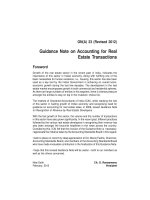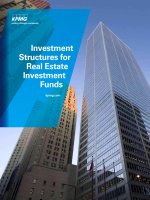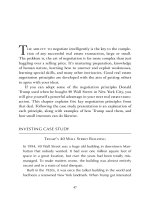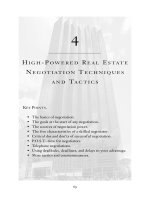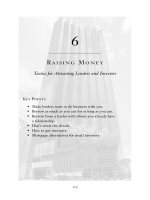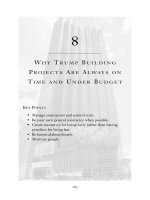MIT Center for Real Estate
Bạn đang xem bản rút gọn của tài liệu. Xem và tải ngay bản đầy đủ của tài liệu tại đây (204.73 KB, 36 trang )
enter for Real EMIT C state
Week 1: Introduction
• The space versus asset market: 4 Quadrant
math.
• Real Estate Micro Economics: Hedonics,
Location, density, government regulations.
• Real Estate Macro Economics: timing
behavior (search, moving, contracts),
cycles, regional growth.
MIT Center for Real Estate
The Role of Real Estate in the
Economy
• Construction [6% of GDP]
• Service flow, “Shelter”, rent plus imputed
rent [20% +
of GDP]
• Assets [55-60% of total national wealth]
• Land? Not part of GDP (we don’t make
land), but it is part of wealth.
• Accounting, measurement difficulties [book
versus market value]
enter for Real E
Construction as a part of GDP
MIT C state
(1990)
$, in billions % of GDP
Private Construction 338 6.1 Public Construction
Buildings 301 5.5 Buildings
Residential Buildings 183 3.3 Housing and Development
Nonresidential Buildings 118 2.1 Industrial
Industrial 24 0.4 Other
Office 29 0.5
Hotels/Motels 10 0.2 Nonbuilding Construction
Other Commercial 34 0.6 Infrastructure
All Other Nonresidential 21 0.4 All Other
Nonbuilding Construction 37 0.7 Total New Construction
Public Utilities 31 0.6
All Other 6 0.1 Total GDP
$, in billions % of GDP
109 2.0
46 0.8
4 0.1
1 0.0
41 0.7
63 1.1
55 1.0
8 0.1
446 8.1
5,514 100.0
Adapted from DiPasquale and Wheaton (1996)
enter for Real EMIT C state
The Value of US Real Estate Assets (1990)
$, in billions % of Total
Residential 6,122 69.8
Single Family Homes 5,419 61.7
Multifamily 552 6.3
Condominiums/Coops 96 1.1
Mobile Homes 55 0.6
Nonresidential 2,655 30.2
Retail 1,115 12.7
Office 1,009 11.5
Manufacturing 308 3.5
Warehouse 223 2.5
Total U.S. Real Estate 8,777 100.0
Adapted from DiPasquale and Wheaton (1996)
enter for Real E
U.S. Real Estate
MIT C state
Ownership, 1990
All Real Estate Residential Only Nonresidential Only
$, in billions % $, in billions % $, in billions %
Individuals 5,088 58.0 5,071 82.8 17 0.6
Corporations 1,699 19.4 66 1.1 1,633 61.5
Partnerships 1,011 11.5 673 11.0 338 12.7
Nonprofits 411 4.7 104 1.7 307 11.6
Government 234 2.6 173 2.8 61 2.3
Institutional Investors 128 1.5 14 0.2 114 4.3
Financial Institutions 114 1.3 13 0.2 101 3.8
Other (Including Foreign 92 1.0 8 0.1 84 3.2
Total: 8,777 100.0 6,122 100.0 2,655 100.0
% of All Real Estate 100.0 69.8 30.2
Adapted from DiPasquale and Wheaton (1996)
Exhibit 2-3: The DiPasquale-Wheaton 4-Quadrant Diagram…
Rent $
Stock (SF)
Price $
Space Market:
Construction
Space Market:
Valuation
Q*
R*
P*
C*
D
D
Construction (SF)
Stock Adjustment
Asset Market:
Rent Determination
Asset Market:
enter for Real EMIT C state
Systems of Economic Equations
• Parameters: Constants that reflect underlying
behavior, α, β, δ.
• Endogenous variables: values that the model
“determines: C, S, R, P.
• Exogenous variables: values that determine the
model’s variables, but which the models variables
in turn do not influence: i, E.
• Equilibrium: Solution to the endogenous variables
given exogenous values and parameters.
• Comparative Statics: How changes in exogenous
variables change equilibrium endogenous ones.
enter for Real EMIT C state
1
st
quadrant
β
1). Office Demand = α
1
ER
-β1
E= office employment
R = rent per square foot
1
= rental elasticity of demand:
[%change in sqft per worker/% change
in rent]
2). Demand = Stock = S
3). Hence: R = (S/α
1
E)
–1/ β1
MIT Center for Real Estate
2nd and 3
rd
Quadrants
4). P = R/i
i = all inclusive cap rate
5). Office Construction rate:
C/S = α
2
P
β2
P = Asset Price per square foot
[“Q” theory?]
β
2
= Price elasticity of supply:
[% change in construction rate/% change
in rent]
MIT Center for Real Estate
4
th
Quadrant
6). Replacement version:
E= fixed
C= δS [Construction equals depreciation
(δ is depreciation rate)]
7). Steady Demand growth version:
∆E/E = δ
Hence: C= δS
[what if S grows less or more than E?]
Exhibit 2
Exhibit 2
-
-
4a: Effect of
4a: Effect of
Demand Growth
Demand Growth
in Space Market:
in Space Market:
Rent $
Stock (SF)
Price $
Construction (SF)
Space Market:
Stock Adjustment
Asset Market:
Construction
Space Market:
Rent Determination
Asset Market:
Valuation
Q*
R*
P*
C*
D
0
D
1
Exhibit 2
Exhibit 2
-
-
4a: Effect of Demand Growth in Space Market:
4a: Effect of Demand Growth in Space Market:
First phase
First phase
…
…
Rent $
Stock (SF)
Price $
Construction (SF)
Space Market:
Stock Adjustment
Asset Market:
Construction
Space Market:
Rent Determination
Asset Market:
Valuation
Q*
R*
P*
C*
D
0
D
1
R
1
P
1
Can this be a long-
run equilibrium
result?…
Doesn’t form a
rectangle.
Exhibit 2
Exhibit 2
-
-
4a: Effect of Demand Growth in Space Market:
4a: Effect of Demand Growth in Space Market:
LR Equilibrium
LR Equilibrium
…
…
Rent $
Stock (SF)
Price $
Construction (SF)
Space Market:
Stock Adjustment
Asset Market:
Construction
Space Market:
Rent Determination
Asset Market:
Valuation
Q*
R*
P*
C*
D
0
D
1
R
1
P
1
R**
P**
C**
Q**
Exhibit 2
Exhibit 2
-
-
4a: Effect of Demand Growth in Space Market:
4a: Effect of Demand Growth in Space Market:
LR Equilibrium
LR Equilibrium
…
…
Rent $
Stock (SF)
Price $
Construction (SF)
Space Market:
Stock Adjustment
Asset Market:
Construction
Space Market:
Rent Determination
Asset Market:
Valuation
Q*
R*
P*
C*
D
0
D
1
R**
P**
C**
R
1
P
1

